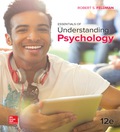
Introduction: Behavior is the capacity of an organism to learn through experience. Learning theories focus on the interactions between the personal, behavioral, and environmental factors that determine the behavior. This is used to describe a process and retain knowledge.
Answer to Problem 1E
Correct answer: Learning involves changes brought about by experience, whereas maturation describes changes resulting from biological development.
Explanation of Solution
The process of gaining information and behaviors through experience is called learning. Humans, animals, and even some machines have the capability to learn. Human learning starts before birth and continues till the end of their life; most of the interactions are with the environment. If a response is associated with a particular stimulus, then it is called associative learning. Associative learning is facilitated by conditioning. The two main forms of conditioning are classical and operant conditioning. Classical conditioning is the involuntary response from the stimulus. The voluntary responses that are adapted by the environmental consequences that obtain benefits to the organism are collectively called operant conditioning. The important elements of learning process involve attention and focus, associations, emotions, and spaced repetitions. Thus, these elements influence the learning process that enhances knowledge and behavior.
Want to see more full solutions like this?
Chapter 15 Solutions
EBK ESSENTIALS OF UNDERSTANDING PSYCHOL
- Evaluate the application of behaviourism and cognitive psychological perspectives to contemporary issues in psychology.arrow_forwardAnalyse the similarities and the differences between behaviourism and cogniperspectives in psychology.arrow_forwardEvaluate the work of key theorists Neisser, 1967 relating to congnitive psychological perspectivearrow_forward
- Evaluate the key assumptions of behaviourism and cognitive psychological perspectives.arrow_forwardable to help me with this for revision purposes and used reference in APA Required reading: • McKevitt, G. (2024, September 2). https://www.bbc.com/culture/article/20240829-the-life-changing-day-world-war-two-beganarrow_forwardWhat strategies and techniques can social workers use to inform and influence organizational and social policy? What are advantages and disadvantages of various policy change strategies and techniques? Please cite in text source and list references.arrow_forward
- What are three professional best practices that school counselors can implement or can recommend in schools after watching the YouTube video titled “The Effective School Counselor with a High-Risk Teen: Motivation Interviewing Demonstration” (https://www.youtube.com/watch?v=_TwVa4utpII) by MerloLab (MerloLab, 2015)? Please write in a narrative format and include citations.arrow_forwardWhat are three strategies school counselors use in schools after watching the YouTube video titled: “The Effective School Counselor with a High-Risk Teen: Motivation Interviewing Demonstration” (https://www.youtube.com/watch?v=_TwVa4utpII) by MerloLab (MerloLab, 2015)? Please write in a narrative format and include citations.arrow_forwardWhat are three interventions or programs school counselors can implement in schools after watching the YouTube video titled “The Effective School Counselor with a High-Risk Teen: Motivation Interviewing Demonstration” (https://www.youtube.com/watch?v=_TwVa4utpII) by MerloLab (MerloLab, 2015)? Please write in a narrative format and include citations.arrow_forward
 Ciccarelli: Psychology_5 (5th Edition)PsychologyISBN:9780134477961Author:Saundra K. Ciccarelli, J. Noland WhitePublisher:PEARSON
Ciccarelli: Psychology_5 (5th Edition)PsychologyISBN:9780134477961Author:Saundra K. Ciccarelli, J. Noland WhitePublisher:PEARSON Cognitive PsychologyPsychologyISBN:9781337408271Author:Goldstein, E. Bruce.Publisher:Cengage Learning,
Cognitive PsychologyPsychologyISBN:9781337408271Author:Goldstein, E. Bruce.Publisher:Cengage Learning, Introduction to Psychology: Gateways to Mind and ...PsychologyISBN:9781337565691Author:Dennis Coon, John O. Mitterer, Tanya S. MartiniPublisher:Cengage Learning
Introduction to Psychology: Gateways to Mind and ...PsychologyISBN:9781337565691Author:Dennis Coon, John O. Mitterer, Tanya S. MartiniPublisher:Cengage Learning Psychology in Your Life (Second Edition)PsychologyISBN:9780393265156Author:Sarah Grison, Michael GazzanigaPublisher:W. W. Norton & Company
Psychology in Your Life (Second Edition)PsychologyISBN:9780393265156Author:Sarah Grison, Michael GazzanigaPublisher:W. W. Norton & Company Cognitive Psychology: Connecting Mind, Research a...PsychologyISBN:9781285763880Author:E. Bruce GoldsteinPublisher:Cengage Learning
Cognitive Psychology: Connecting Mind, Research a...PsychologyISBN:9781285763880Author:E. Bruce GoldsteinPublisher:Cengage Learning Theories of Personality (MindTap Course List)PsychologyISBN:9781305652958Author:Duane P. Schultz, Sydney Ellen SchultzPublisher:Cengage Learning
Theories of Personality (MindTap Course List)PsychologyISBN:9781305652958Author:Duane P. Schultz, Sydney Ellen SchultzPublisher:Cengage Learning





